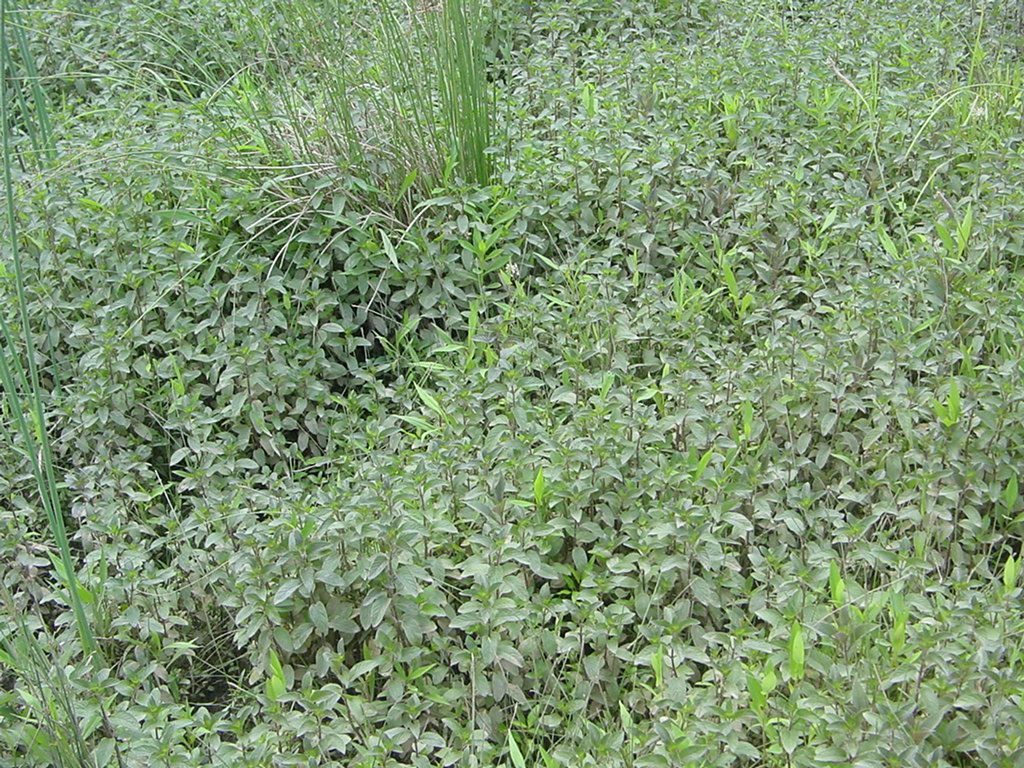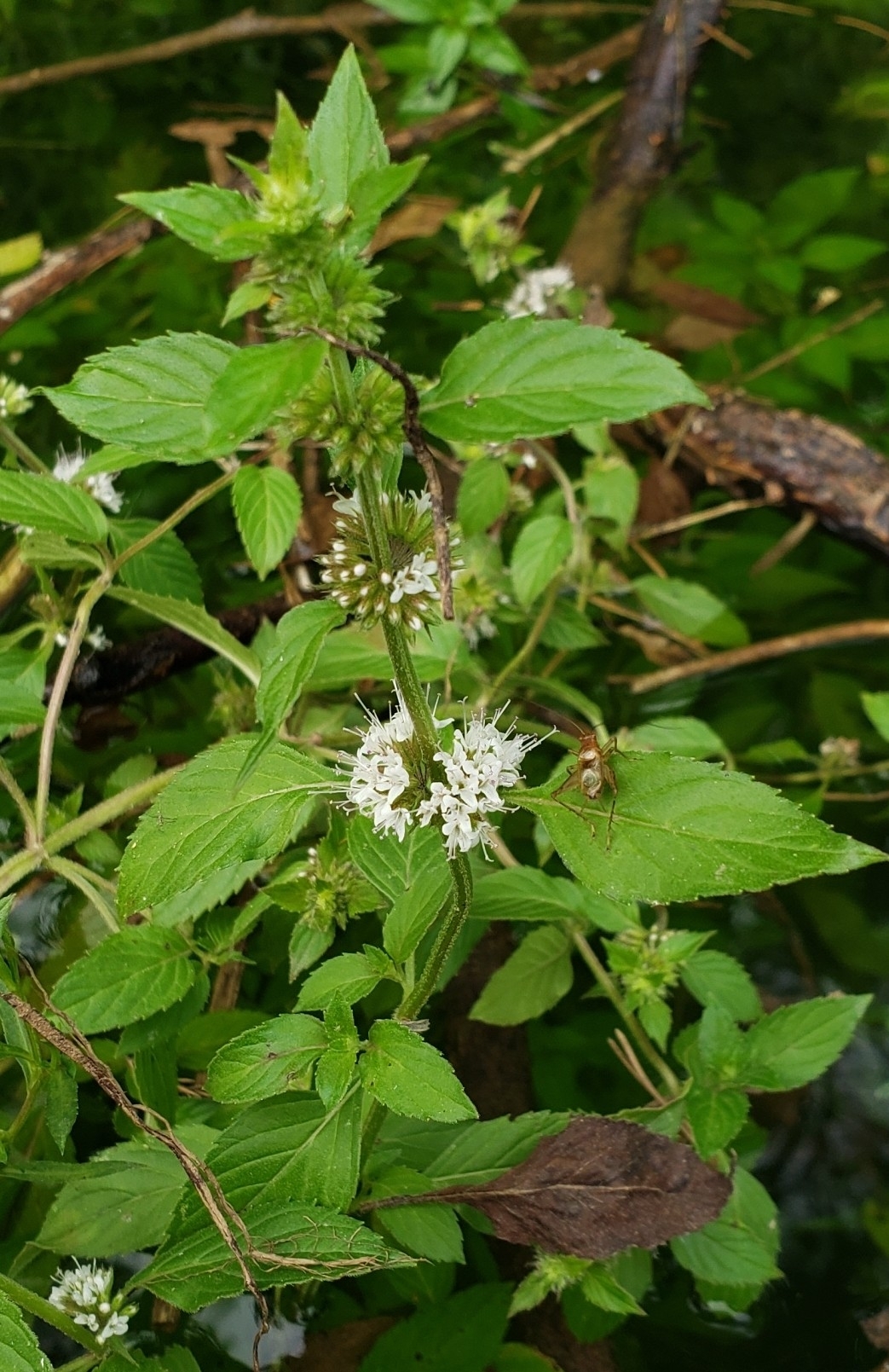Native Plants of Leesville Lake
This quartly column will be about native plants that live at or below the 613 foot conture level of Leesville Lake. Leesville Lake fluctuates between 613 and 600. Each issue will feature a different species. Plant life along the shores lowest reach is arround the 605 level. Various species tolerate this levels of the lake where as others only grow at the higher ones likeing only wet feet verses waist high or higher water. Short plants at lowest levels are compleatly under water for hours if not a day or two at times. The fluctuating water of Leesville Lake makes for a larger zone of habitat for marsh plants than "normal" lakes. So like they say when given limons make limonade.
Hibiscus moscheutos
marsh hibiscus
Hibiscus moscheutos is native to Leesville Lake. It has a range of common names, eastern rosemallow, common rose mallow, swamp mallow, marshmallow and marsh hibiscus. It blooms June to frost with a variety of colors, red, pink, rose, and white. The flowers on the ones I have seen on Leesville are white with a crimson eye and three to four inches in diameter.Thus the name crimsoneyed rosemallow is a best fit for the varieties at Leesville Lake.
Varieties of hibiscus moscheutos can grow from 4 to 8 ft high and be as wide as 3 ft. while atttracting butterflies, songbirds, and beneficial insects. Some of these cold hardy perennial can have blooms as large as 12 inches accross. You can find them growing in full sun to partial shade. At Leesville you can find them mostly in the backs of coves but also along the cove shores where the soil or mud is soft. They can root in as low as the 605 but seem a bit healther higher on up. Nevertheless they love the the drawdown and reflooding of the lake.
Clusters of seed capsules form quickly after blooming then mature and turn brown. They will eventually split open, allowing seeds to scatter. Some seed capsules may fall from the plant with seeds intact and they will float allowing the back and forth currents of Leesville Lake to disperse them maybe to a cove close to you. You ann cut them back to near ground or mud level after frost but wait untill the seeds have fallen.
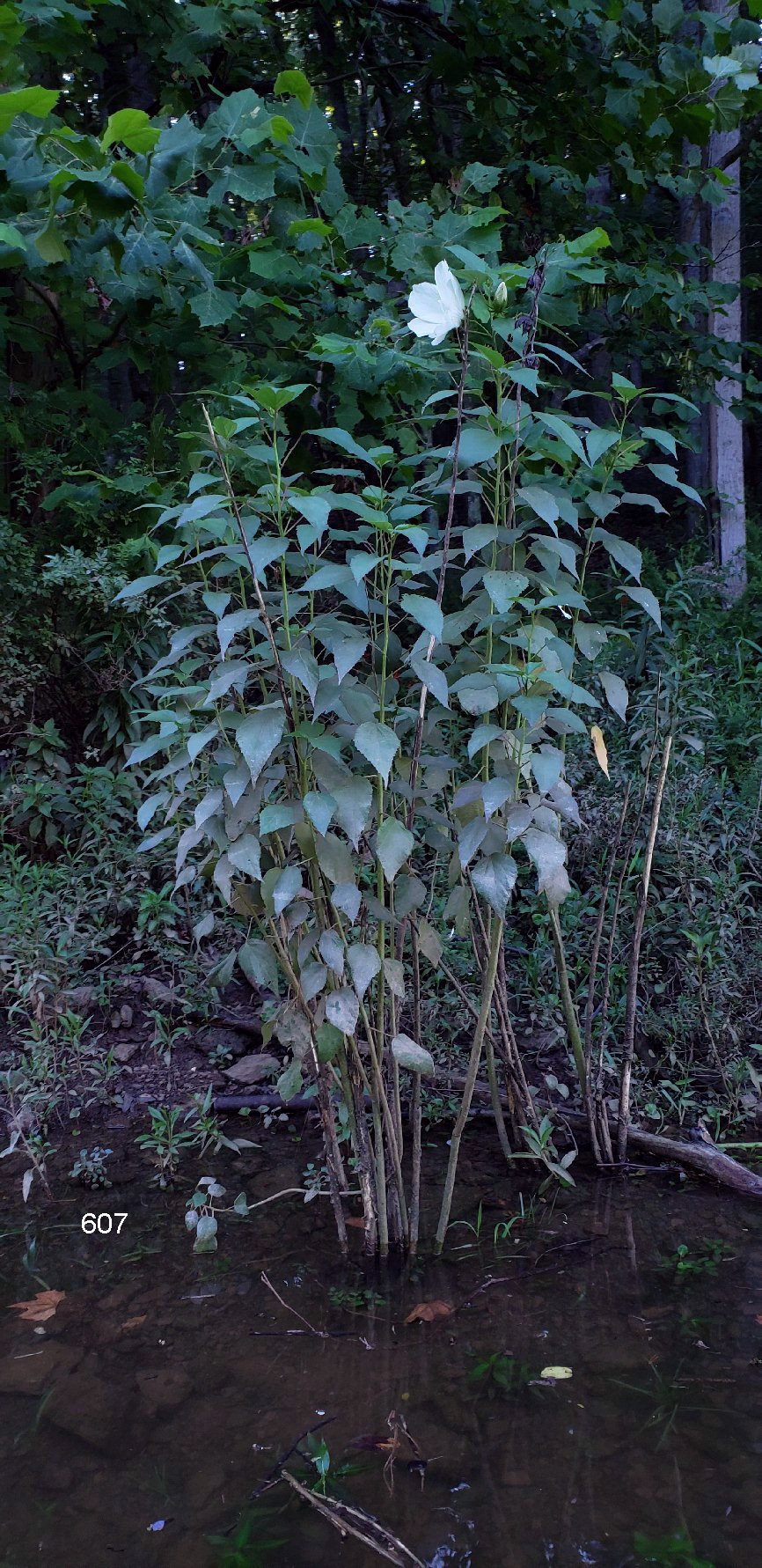
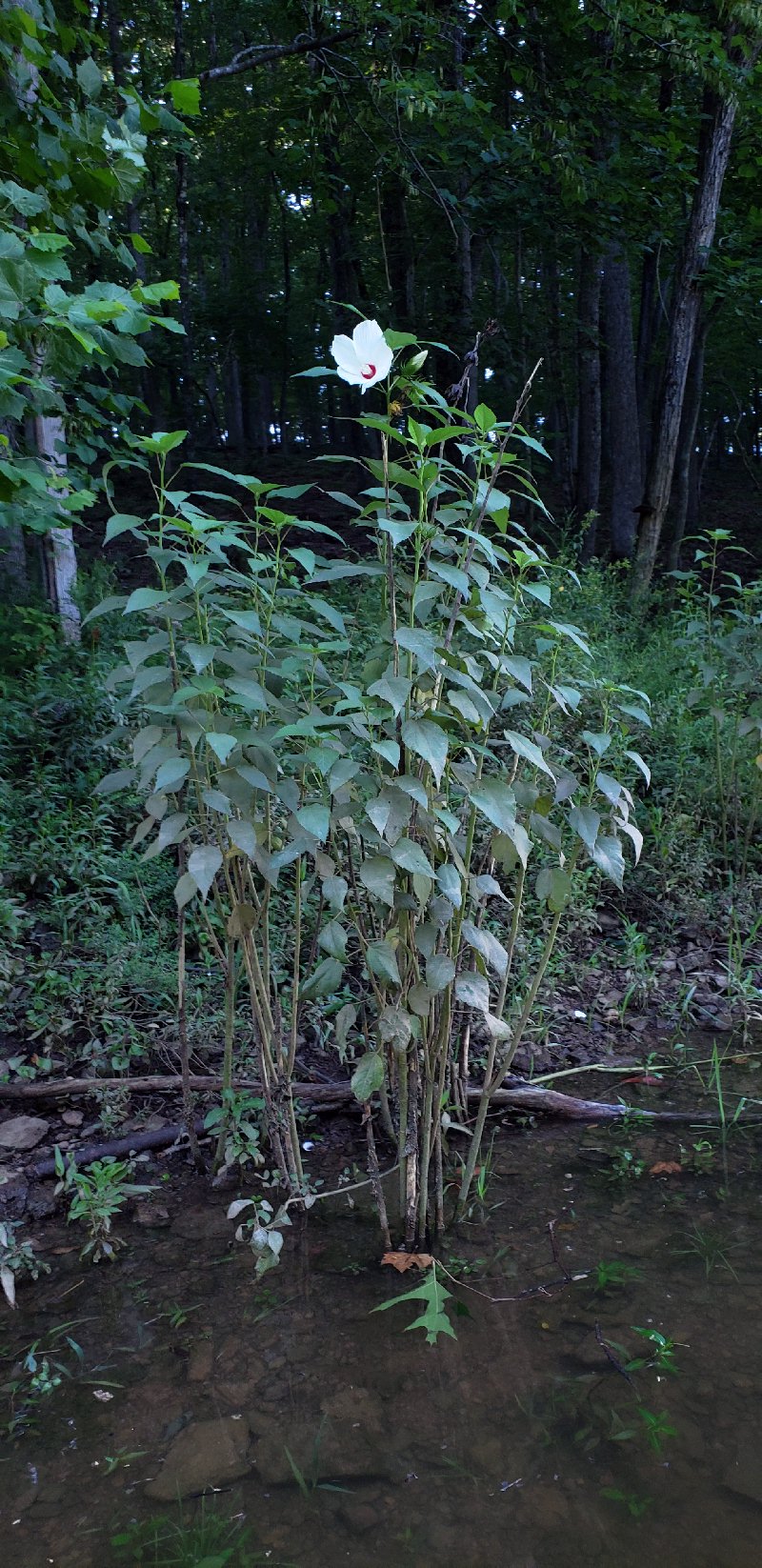
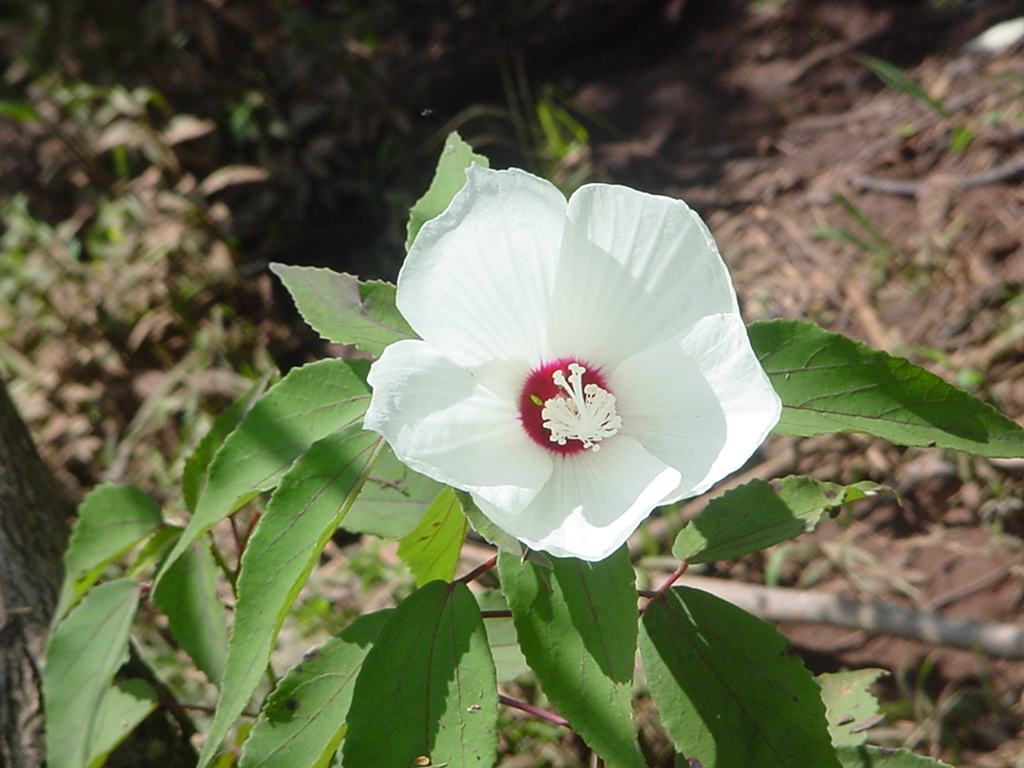
Lobelia cardinalis
Cardinal Flower
Lobelia cardinalis or Cardinal Flower can be found from Canada south thru the eastern and central United States where the soil is moist. This perennial can grow from 1 to 5 ft. tall and topped with 8 inch red flower spikes from May thru October. European explorers gave the plant it's name because the flowers resemble the bright red robes worn by Roman Catholic cardinals. The dark green leaves make it a great addition to a woodlands edge garden or in ditches, ravines and near lakes and ponds. A plant will die back in the fall and next spring several offshoots will come back from the clump and flower again.
Because the flowers are long and tubular only birds , butterflies and hummingbirds will pollinate them. With very few pests and not favored by deer or rabbits, Cardinals are very successful in the wild, forming beds of dark green topped with red or found on their own among other stream bank, swamp loveing species.
Walk canoe or kayak along the shores of Leesville Lake and I am shure you will see one or several especially in the backs of coves where beds can be quite large along a gently sloping wooded bank. Every location where I have scouted along the lake has had at least a few of them. The capsules formed from the flowers contain numerous small seeds that will scatter on the mud and germinate next spring.
The finely ground roots of Cardinal Flower were used by some Native Americans as aphrodisiacs and love potions, but the plant is toxic if eaten in large quantities. Booiling with the roots of other plants made a liquid used to treat fever sores while adding stems leaves, and blossoms was drunk for for cramps or induce vomiting for an upset stomach.
In October cut the stalks below the capsules and put upside down into a bag leaving it open for air circulation. In a few days a good shaking of the bag will release the seeds from some of the capsules while others will need to be crushed and the seeds picked out. Seeds can be planted right away in a greenhouse.
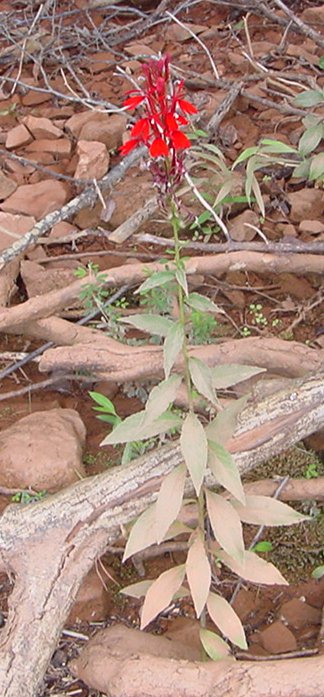
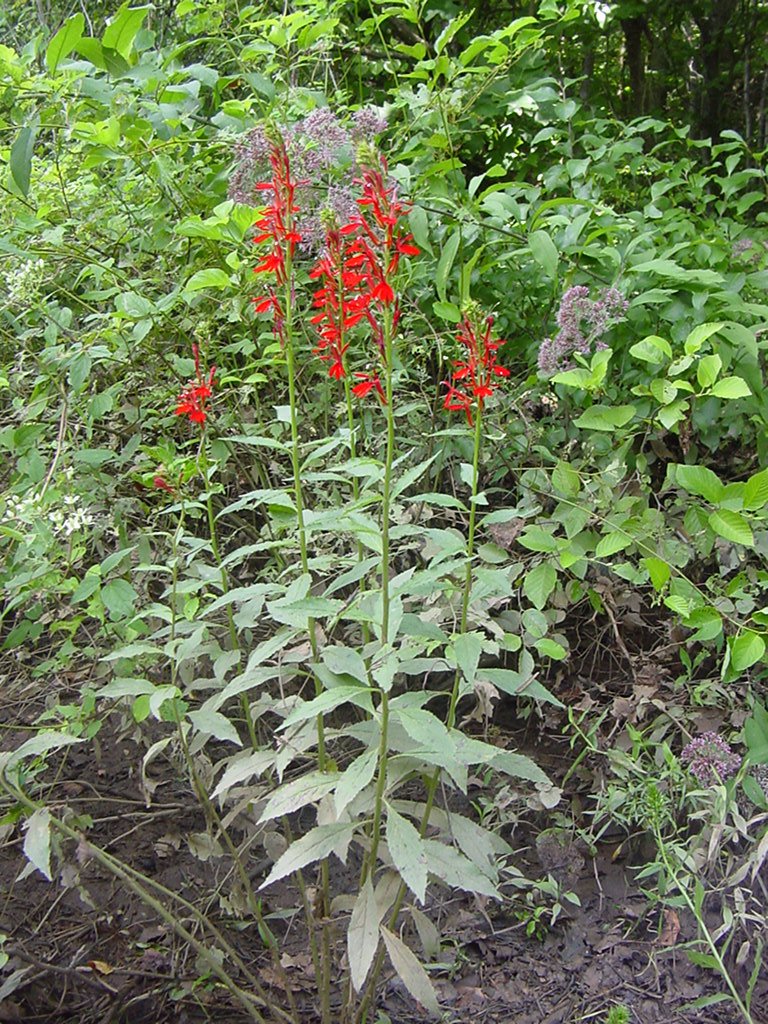
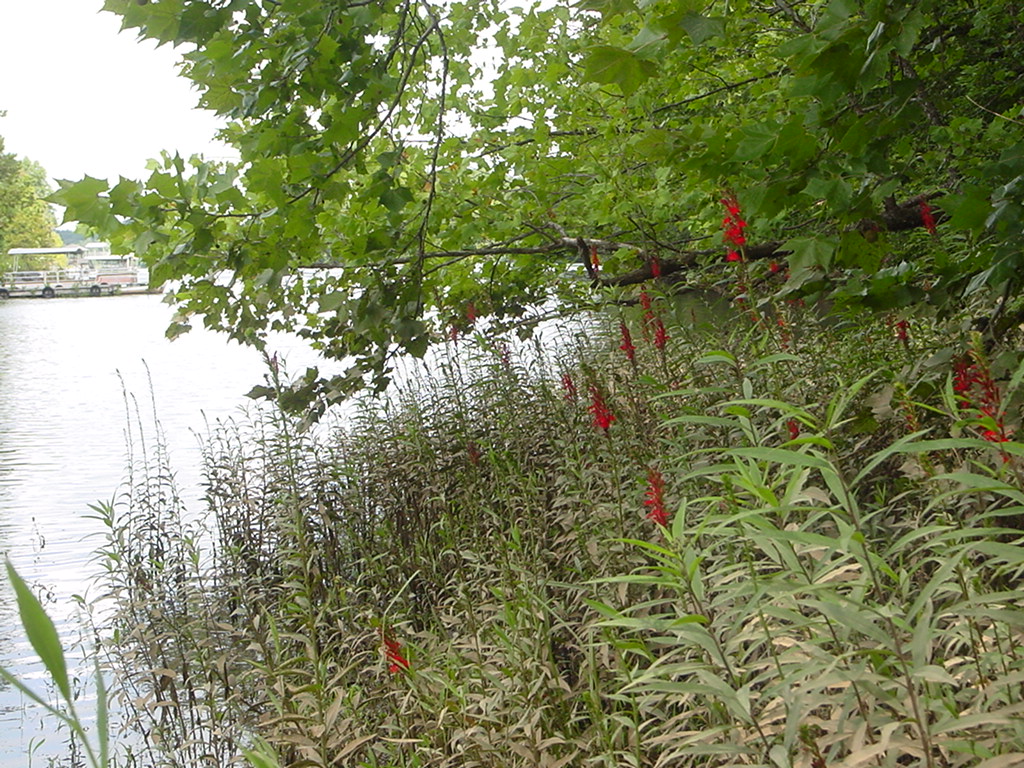
Helenium autumnale
Sneezeweed
Helenium autumnale, a member of the aster family, is a 2-5 ft., erect perennial with many elongate leaves and numerous flower heads. It has a winged stem bearing yellow, daisy-like flower heads with fan-shaped, drooping rays. The disk flowers form a conspicuous, greenish-yellow, ball-like structure at center of the head. The flowers have raised centers and have wedge-shaped, yellow petals that end in three teeth. Its common name, Sneezeweed, does not derive from the effects of its pollen, but rather, it is based on its former use; its dried leaves can be made into a snuff and then inhaled to cause sneezing that would supposedly rid the body of evil spirits. Perhaps more practically, it was also used as a way to loosen up a head cold by sneezeing.
Sneezeweed is also known as Helen's flower and false sunflower. The genus name, Helenium, refers to the famous Helen of Troy. There is a legend that these flowers sprang from the ground where Helen's tears fell.
It's yellow blooms can be seen from July thru October in moist, open areas along streams & ponds and wet meadows. The plant attracts butterflies and is of special value to native bees capabable of attracting large numbers. It grows in sunny areas above the 607 ft contour of Leesville Lake scattered among the other plants or on its own. It is native in all of the lower 48 states and the southern half of Canada. The local varities have more yellow and less green in the center ball.
By the way in the background of the picture is an invasive weed named tall lespedeza. Desroy them when ever you can.
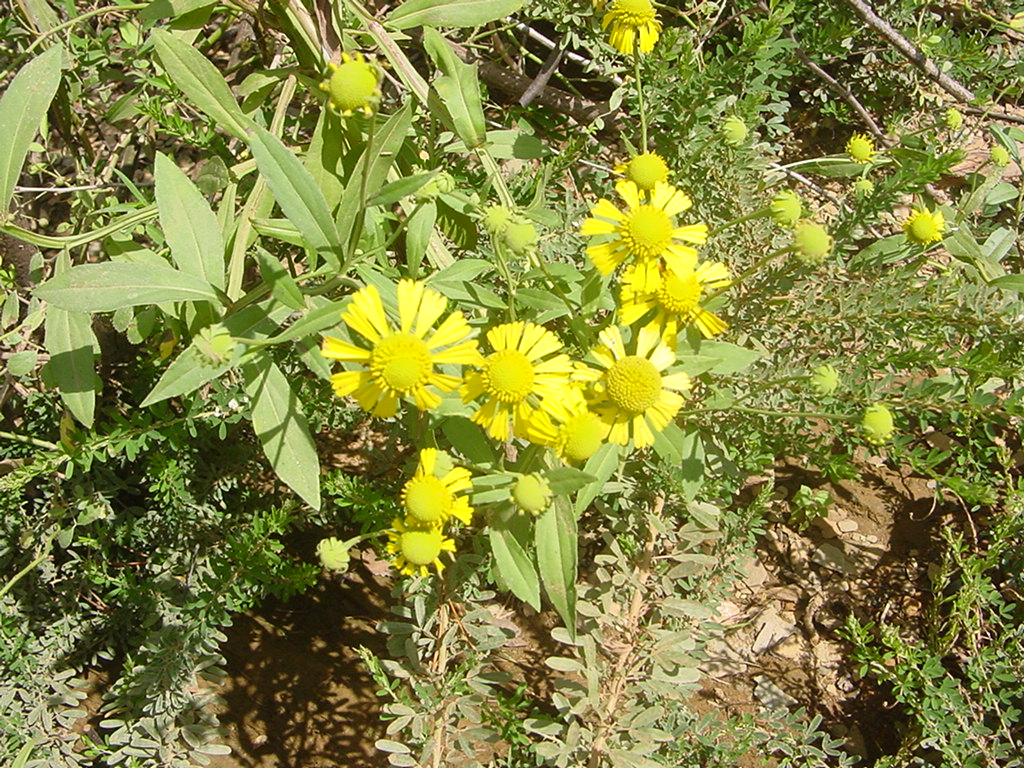
Vernonia noveboracensis
New York Ironweed
New York Ironweed is a herbaceous perinial in the aster family which grows to be 5 to 8 feet tall with deep purple 3 to 4 inch wide flower clusters that
form a loose spray. It grows in wet bottom lands, along stream banks and in Leesville Lake above 606 feet. Plants below 607, which are submerged for
extended periods, survive with stunted growth and never develope flowers. The common name is atributed to the "iron like" qualites of tough stems,
rusty-tinged fading flowers leading to rusty colored seeds as well as living submerged in Leesvile Lake. The genus name is in honor of
William Vernon who was an Elglish botanist that spent time in Maryland around 1698 collecting plants to take back home for study.
Noveboracensis is latin for New York but only used in botanical names.
Ironweed can grow as one stem towering above the other plants, or as a clump with many stems producing several flower heads. A gardener can cut
it back in the spring to force clumping or cut a clump to varring heights to get a more interesting specimen when it blooms in August.
Plants have rough lanced shaped dark green leaves that are 6 to 8 inches long. Unlike the deer that leave Ironweed alone, bees, butterflies and birds
love it. Propagation can be done by making softwood cuttings in the spring or from seeds sown thickly in the fall because germination is low.
Flower heads form nutlets which mature 3-4 weeks after the blooming. Store collected seed in sealed refrigerated containers and refrigerate for
three months before sowing at other times of the year. Also propagation can be done by dividing clumps.
Very similar in apperance and habit is Vernonia crinita alba except, as you may have already deduced, has white flowers. In my below 613 plant
hunting adventures I have found only one small community of a number of individuals you could count on one hand.
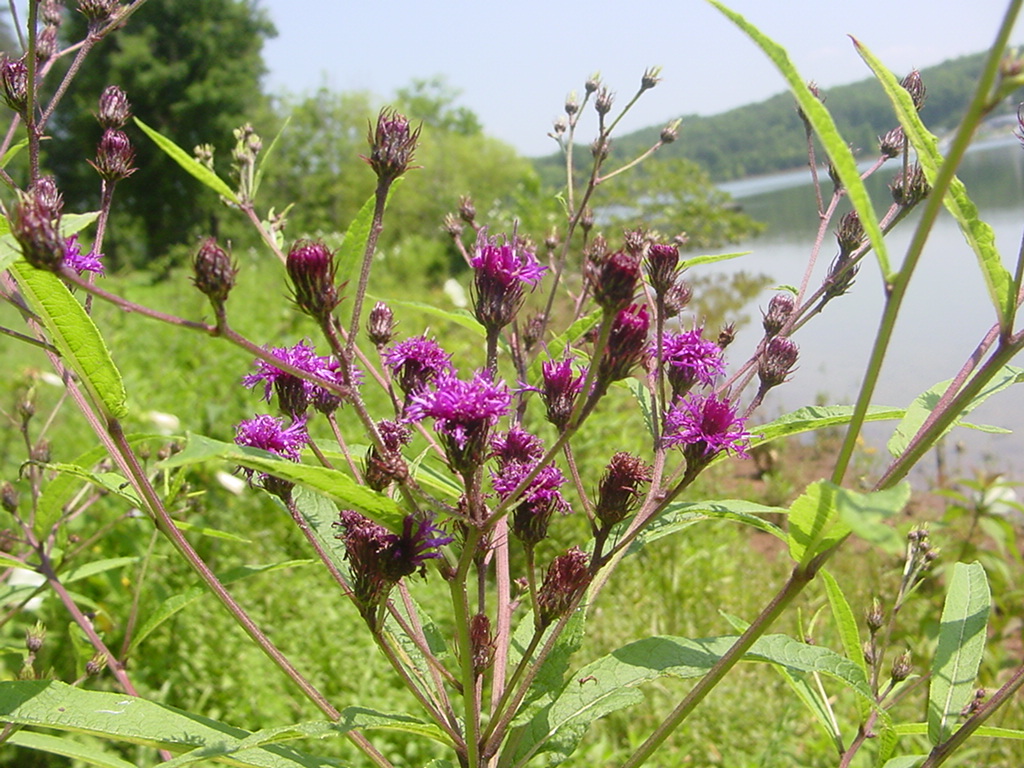
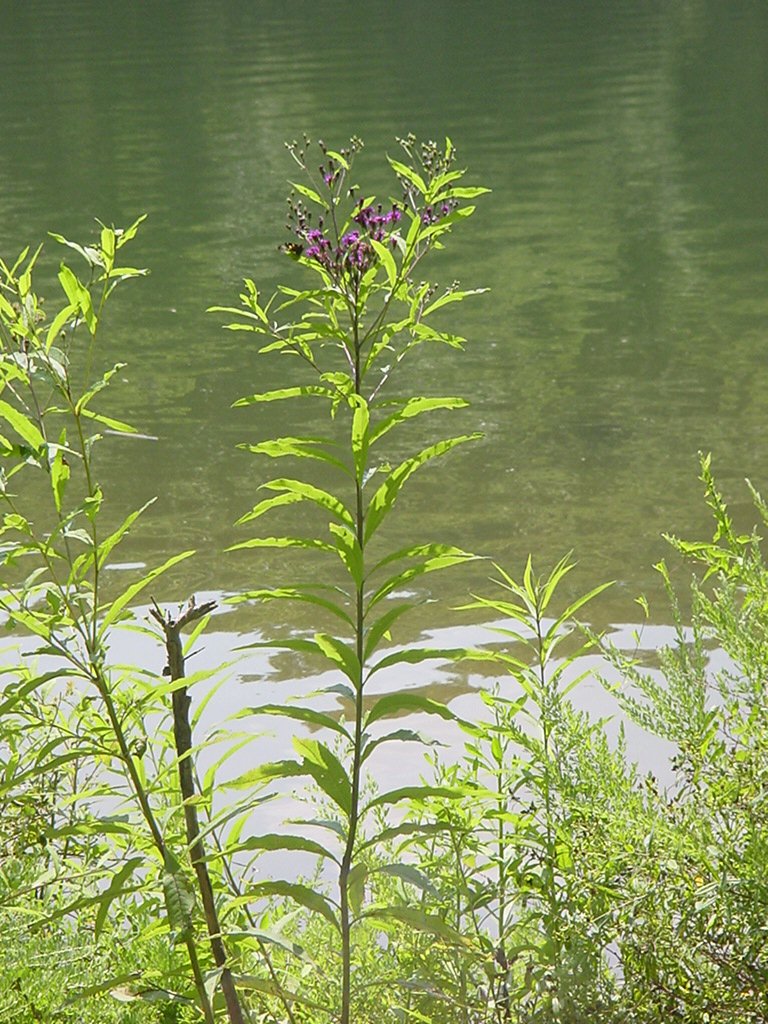
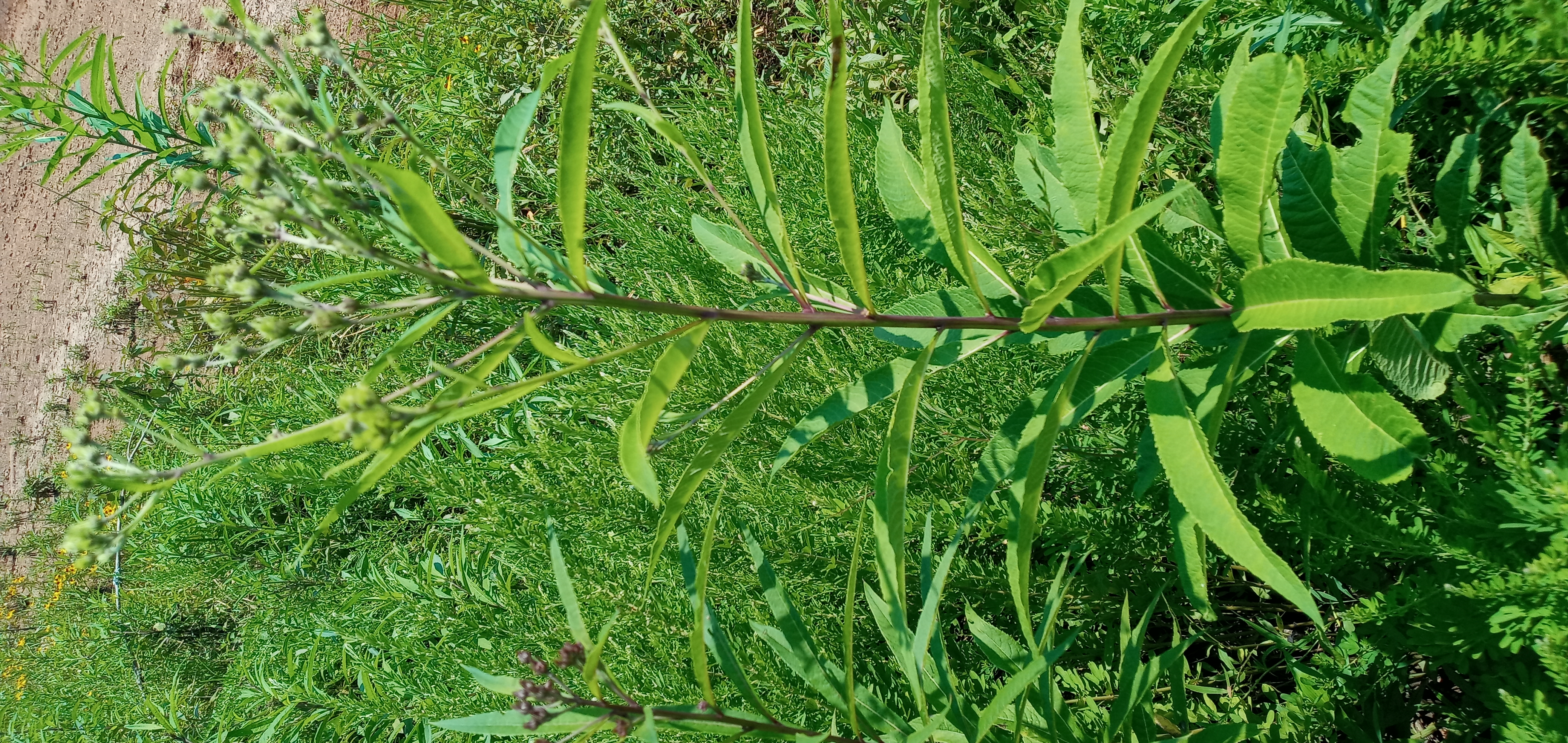
Cephalanthus occidentalis
buttonbush, honey bells
Buttonbush is a deciduous shrub which grows 6-12 ft. tall or occasionally taller and 8 ft. wide with lots of branches bearing glossy green leaves, giving it a bushy appearance.
Mature spherical pin cushion-like golfball size white flowerheads dscorate the plants June thru August. Each is comprised of many scented, creamy-white tubular flowers packed closely together lasting up to 4 days.
After the flowers are fertilized by a variety of pollinators, a hard-ball of first green then reddish-brown nutlets develop and mature from August to November persisting into winter. They provide nector for pollinating insects and hummingbirds and later food for a variety of waterfowl as well as beauty for humans.
Known as honey-bells to beekeepers, buttonbush was cultivated as far back as 1735. It was prized for it's long blooming period and continued blooming during the heat of summer when other plants wane. It also is used to develop and restore wetlands, control erosion in riparian areas, and create wildlife habitats. Sounds like a great fit for Leesville Lake. It likes sun but can take a little shade but it has to have wet soil. It can even grow in 3 ft. of water. In Leesville Lake it can grow to the 605 but does better a bit higher.
Buttonbush spreads by seeds and also by shoots arround the base comming up from the roots. You can also take a cutting and stick it into wet ground and it will root.
Errant branches can be pruned back to hold the shape but if it gets unrulely prune back close to the base in early spring. Taller ones can be pruned to be a small multi-branched tree.
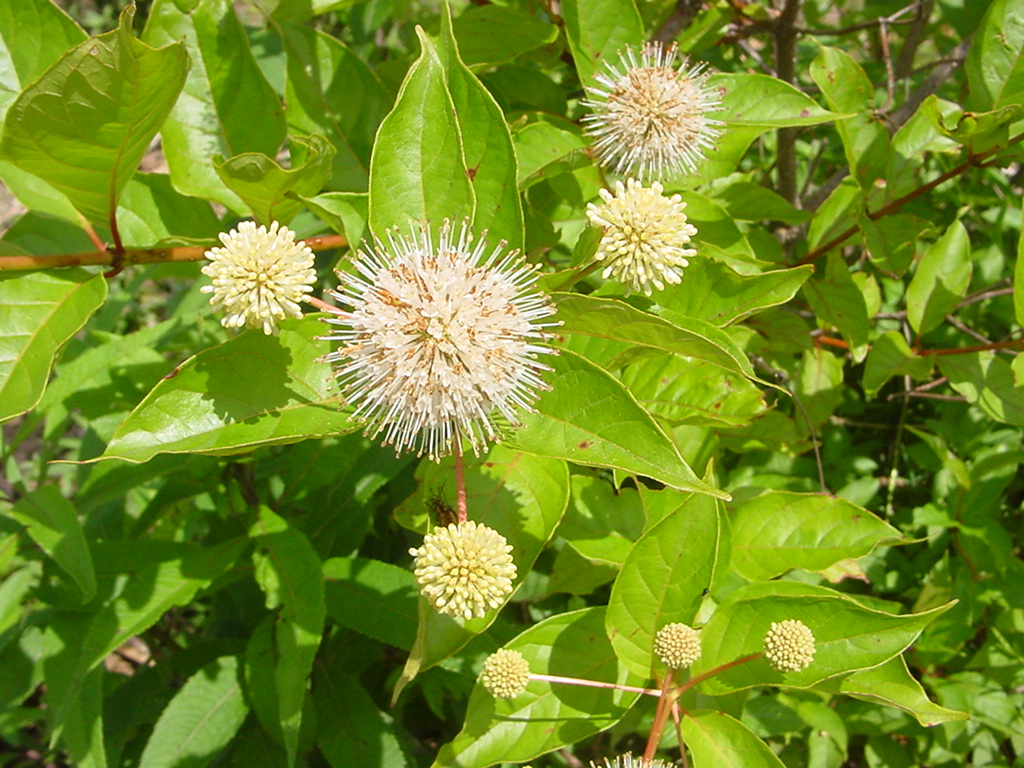
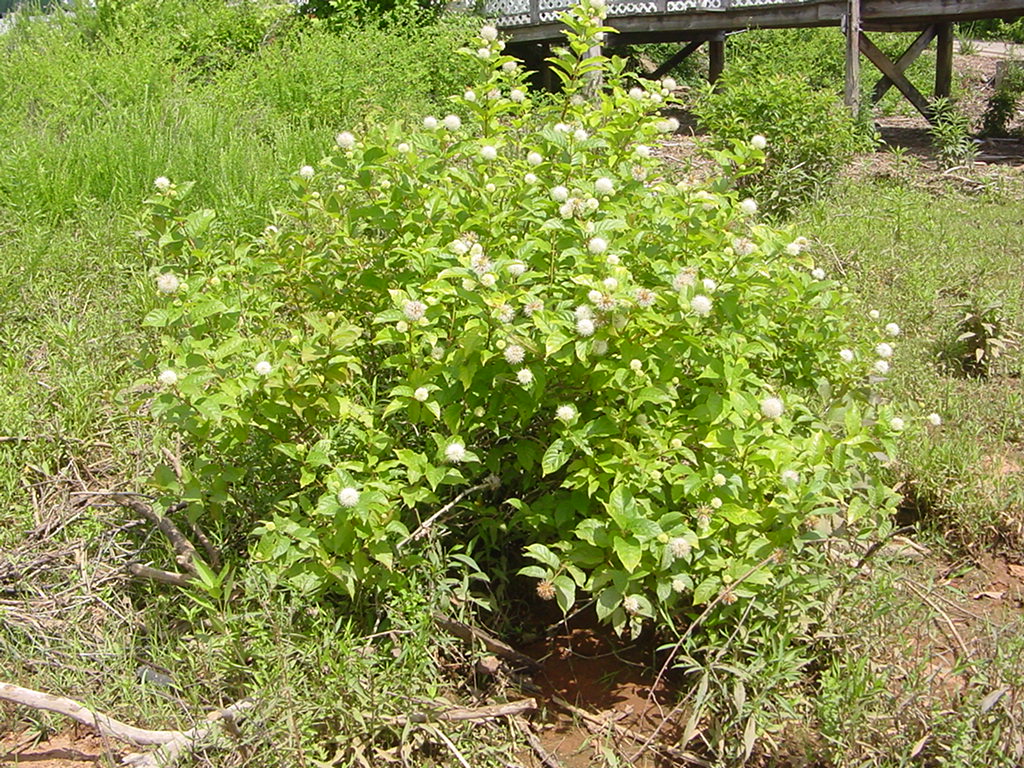
Eupatoriadelphus fistulosum
Joe-pye weed - Trumpetweed - Hollow Joe-pye weed
Joe-pye weed grows in the upper area of the Leesville Lake fluctuation zone. It grows 3 to 7 feet sometimes up to 10 feet tall and can be seen towering over the foreground plants. Common along stream banks and moist ditches, it is a fine fit for lake life. The lanced-shaped leaves can be as long as 10 inches and arranged in whorles of 4 to 7 along a hollow single stem. Many flower heads, each with 4 to 8 pink disc florets, form a dome at the top of the stem from as early as July and as late as September. They attract many pollinators like bees and butterflies as well as hungry songbirds when seeds mature.
Trumpetweed, so named for the hollow stem, forms clumps and colonies by growing rhizomes, and can be propagated by division in late fall. Besides sowing seed, cuttings can be rooted in spring from growing tips.
In the early 1800's a Native American medicine man by the name of Joe Pye used this plant to cure typhoid fever in New England. Native Americans made a tea from the leaves and used it as a diuretic. A tea of the roots has been used to treat fevers, colds, chills, sore womb after childbirth, diarrhea, and liver and kidney ailments. The dried stems and leaves can be burned to deter mosquitoes. Also a dye can be made from it to give golden color to yarn or fabric.
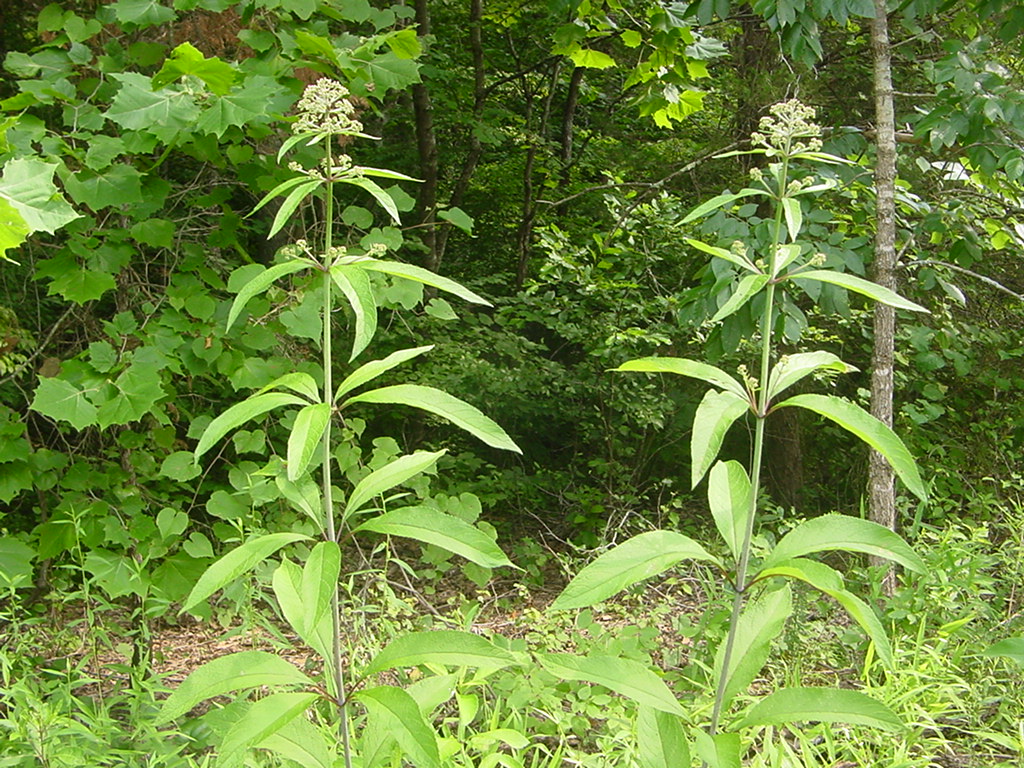
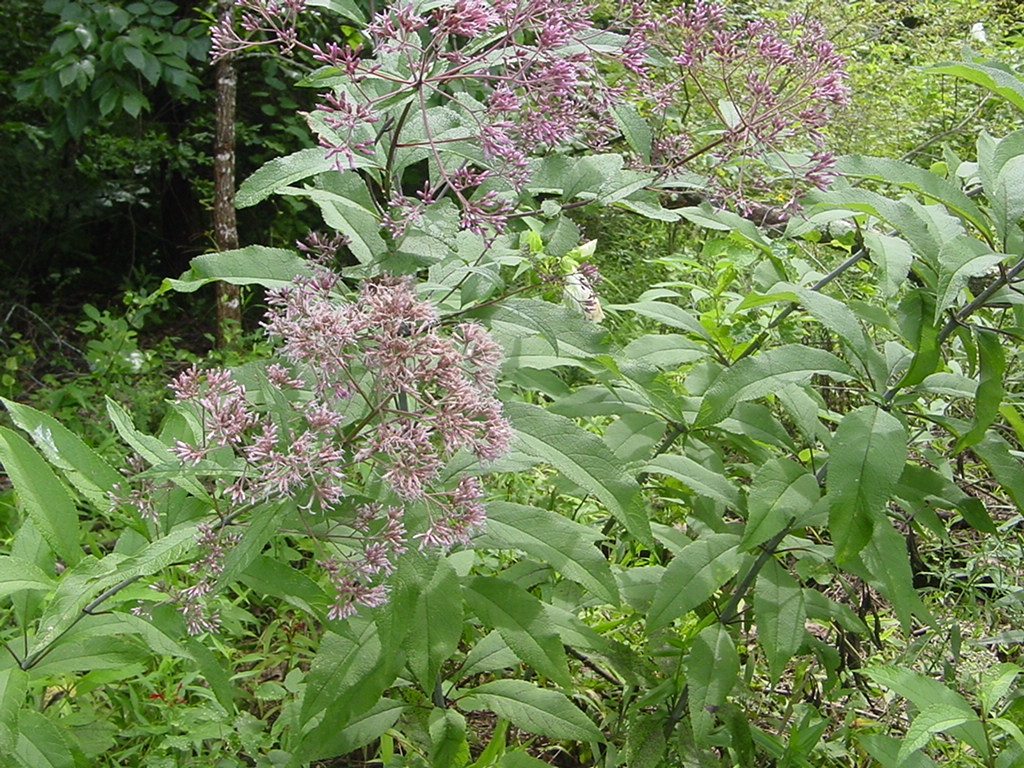
Hypericum prolificum
Shrubby St. John's Wort
Of the numberious varieties of St. John's Wort, Hypericum prolificum is what it's common name implies, a shrub growing upright to about 1 to 4 feet tall and having a rounded compact apperance. It's lower stems are woody. It blooms in the summer for about two months. The bright yellow flowers, up to 1 inch in width, have five petals with numerious yellow stamens that are so bushy that they partially obscure the petals thus the sientific name prolificum. The flowers, offering only pollen with no nector, are cross-pollinated primarily by bumblebees, which collect the pollen for their larvae, that transforms them into a dry seed capsule that persist all winter.
The genus name comes from the Greek words hyper meaning above and eikon meaning picture in reference to the practice of hanging flowers from this genus above images, pictures or windows. Plants were apparently gathered and burned to ward off evil spirits on the eve of St. John's Day. Some species have been used since ancient times in the treatment of wounds and inflammations.
Hypericums have a phototoxic chemical named hypericin that in the presence of light can cause rashes to develop on light-skinned animals. It can irritate the gastrointestinal tract if ingested, so mammals do not bother it.
Shrubby St. John's Wort grows along the upper reaches of the fluctuation zone of Leesville Lake usually out of the side of the bank or even from the rocks. They can root into the crevices between the slabs of sedimentary rock and survive quite well. It will grow in full sun to part shade. They are drought tolerent as well as flood enduring.
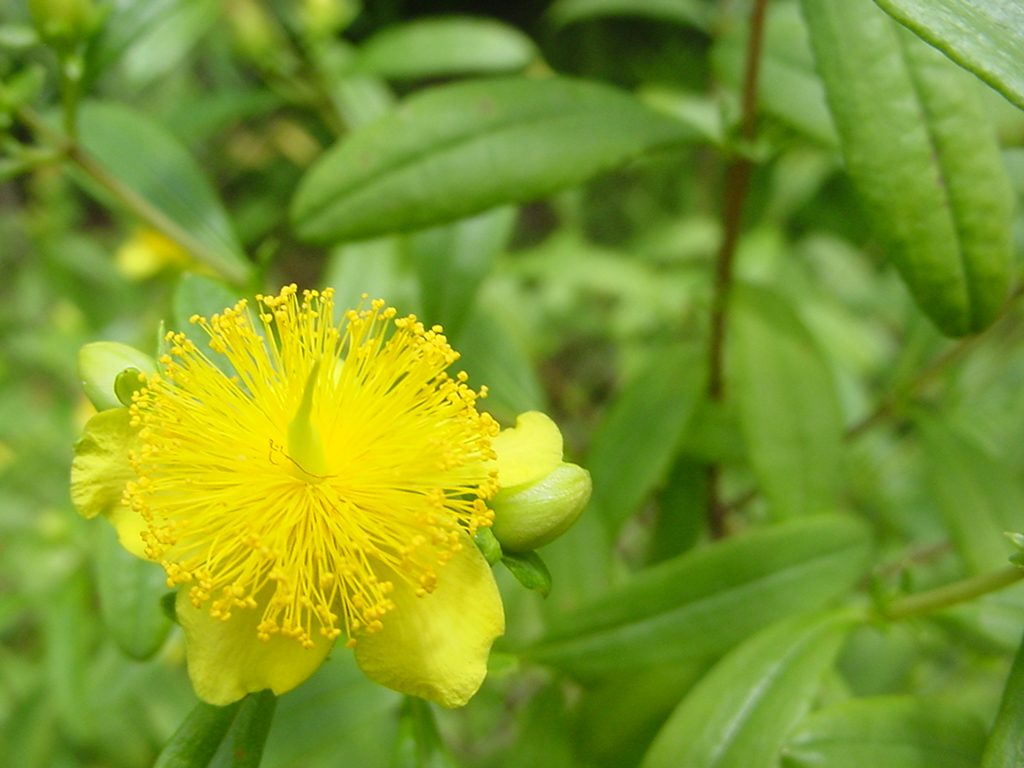
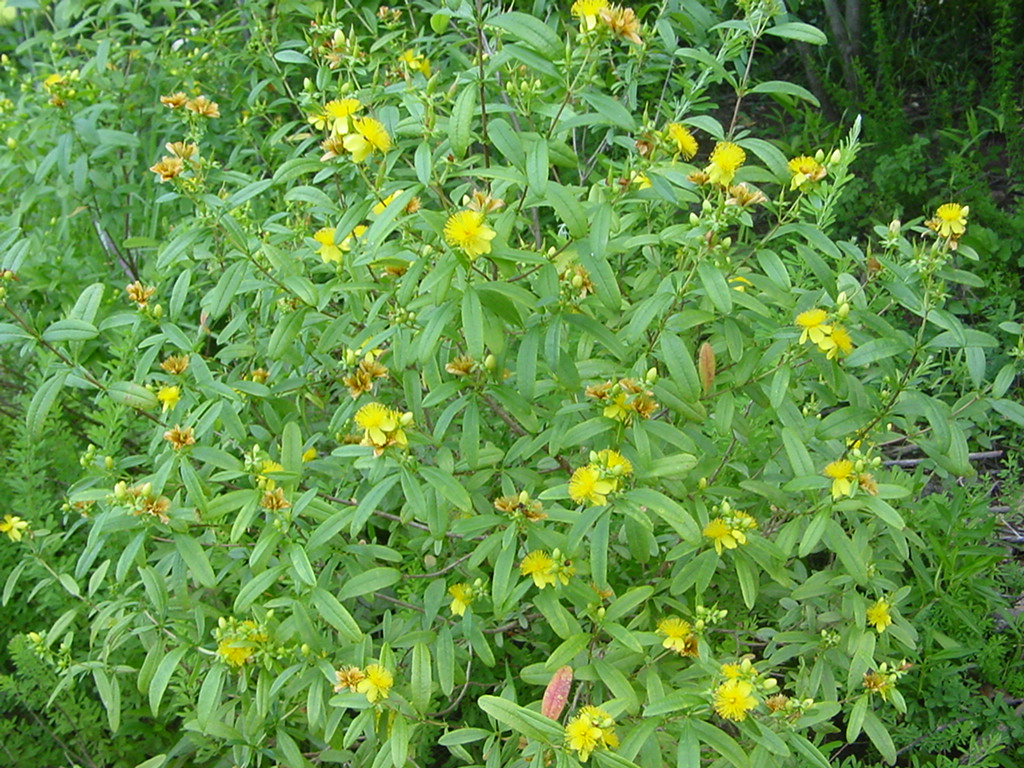

Asclepias incarnata
Swamp Milkweed
Swamp Milkweed is a herbaceous perennial that may grow up to 5 feet tall. It has long thin pointed green leaves on multible vertical stems growing from a clump when exposed to full sun are often purplish toward the end of the growing season. The flower buds emerge white and mature to a pink or rose-purple before opening from mid spring to early fall. Adult Monarch Butterflies, Hummingbirds, and Native Bees feed on the nector. After polination flowers turn into 4 inch long tan-brown seed pods that ripen and split open releasing silky-haired seeds that float on the wind.
It is native to wet sites and thrives in mucky clay soils but also adapts to drier sites in average moist clay or loam soils. On Leesville Lake it grows around 610 and above, prehaps on a clay plateau. Break a branch or twig and a juice flows forth that is less milky than its upland cousins.
A tea made by simering the roots was made in the past and taken in small amounts as a general purge and also to rid the body of parasitic worms. Aesculapius was the Greek god of medicine as swamp and other milkweeds were used treat a varity of ailments. Raw leaves and stems are toxic so no wounder the deer do not touch them. Incarnata in Latin means "flesh-colored". The young shoots, leaves and seed pods are all edible when they have been cooked. Just bring to a boil and simmer till tender to bring forth the delicate flavour.
They are easy to start from seed collected in October and November or from established clumps divided in spring.
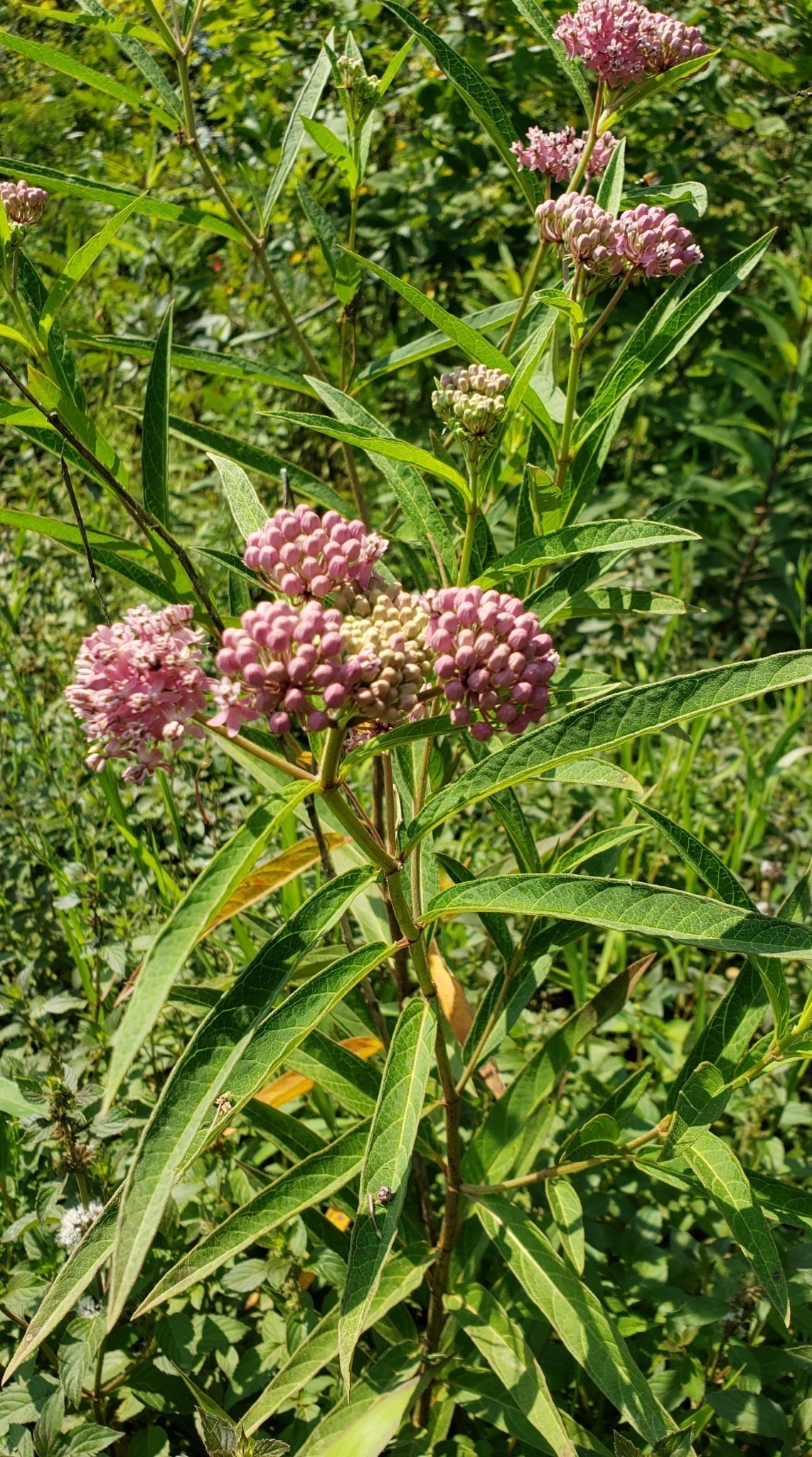
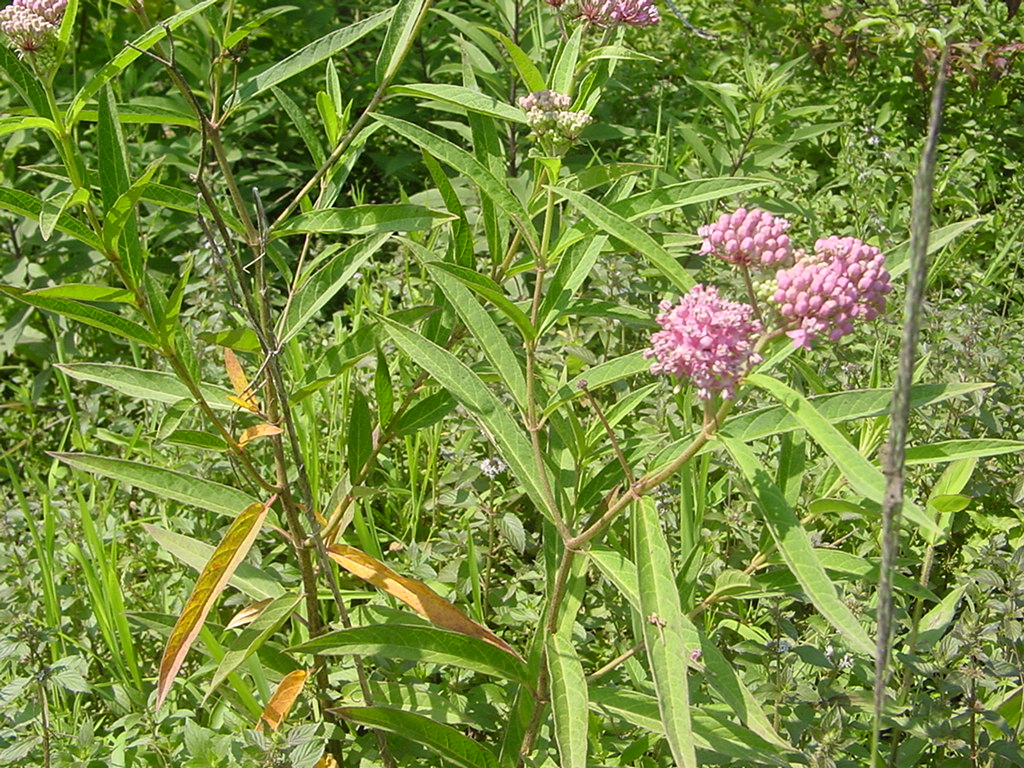
Alnus serrulata
hazle alder, smooth alder, tag alder
Tag Alder is a large deciduous shrub having ovate dull green leaves with serrulate (sharp forward-pointing teeth) margins.
It grows 10 to 15 feet tall from a multi-stemed trunk toped with dense branches making it very atractive in the landscape. It thrives in boggy soil often seen along the banks of streams, rivers, and lakes as well as the margins of wetlands. It can grow in medium to heavy clay and nutritionally poor soils. The roots are thick and spreading with nitrogen fixing noduals and spreading rizomes that form new trunks. Alder is often used in reclimation projects along with other plants that can benifit from the nitrigen it produces. It likes full sun but can tolerate up to a half a day of shade. If near by trees grow and spread their branches eventualy shading them for most of the day they will decline over time even die.
Alders have male and female flowers on seperate catkins. Slender cylindrical male catkins, 2 to 4 inches long, with brownish-yellow flowers, emerge in late winter to early spring drouping from just below the branch tips in clusters of 2 to 5. Emerging from the branch tips at the same time, female catkins are upright 1/4 inch cylinders with bright red flowers and are polinated by the wind.
They then develop into 3/4 to 1 inch long fruiting cones called strobiles that contain the winged nutlet seeds. They turn dark brown in the fall with woody scales looking like little pine cones and stay on the stems thru February. They attract birds that find the seeds a tasty treat.
On Leesville Lake they can be found in the upper reaches of the flood zone above about 610 where they tolerate some flooding. Alder is great for hiding the eroded banks and slowing the erosion as well.
Make a tea from the bark to treat a variety of ailments such as coughs, toothaches, and other pains. It can be used as a diuretic to increase kendiney function or an emetic to induce vomiting as well as a laxative. Also use it as an eye wash. Boil the bark or the cones to a cream to use it externaly for hemrroids, hives, poison ivy, swellings, sprains, reduce bleeding from skin abrasions, contract skin cells, and make skin less oily.
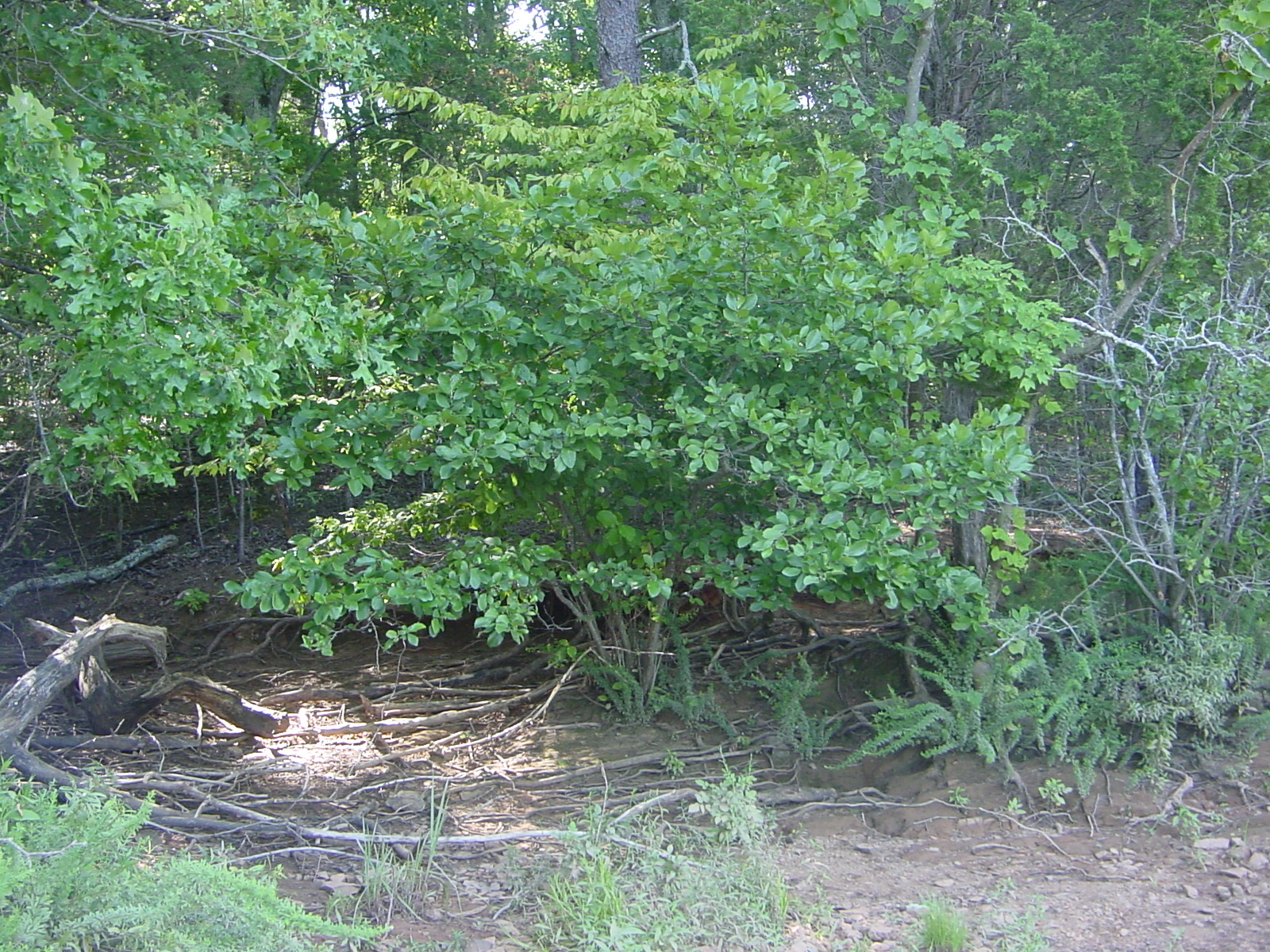
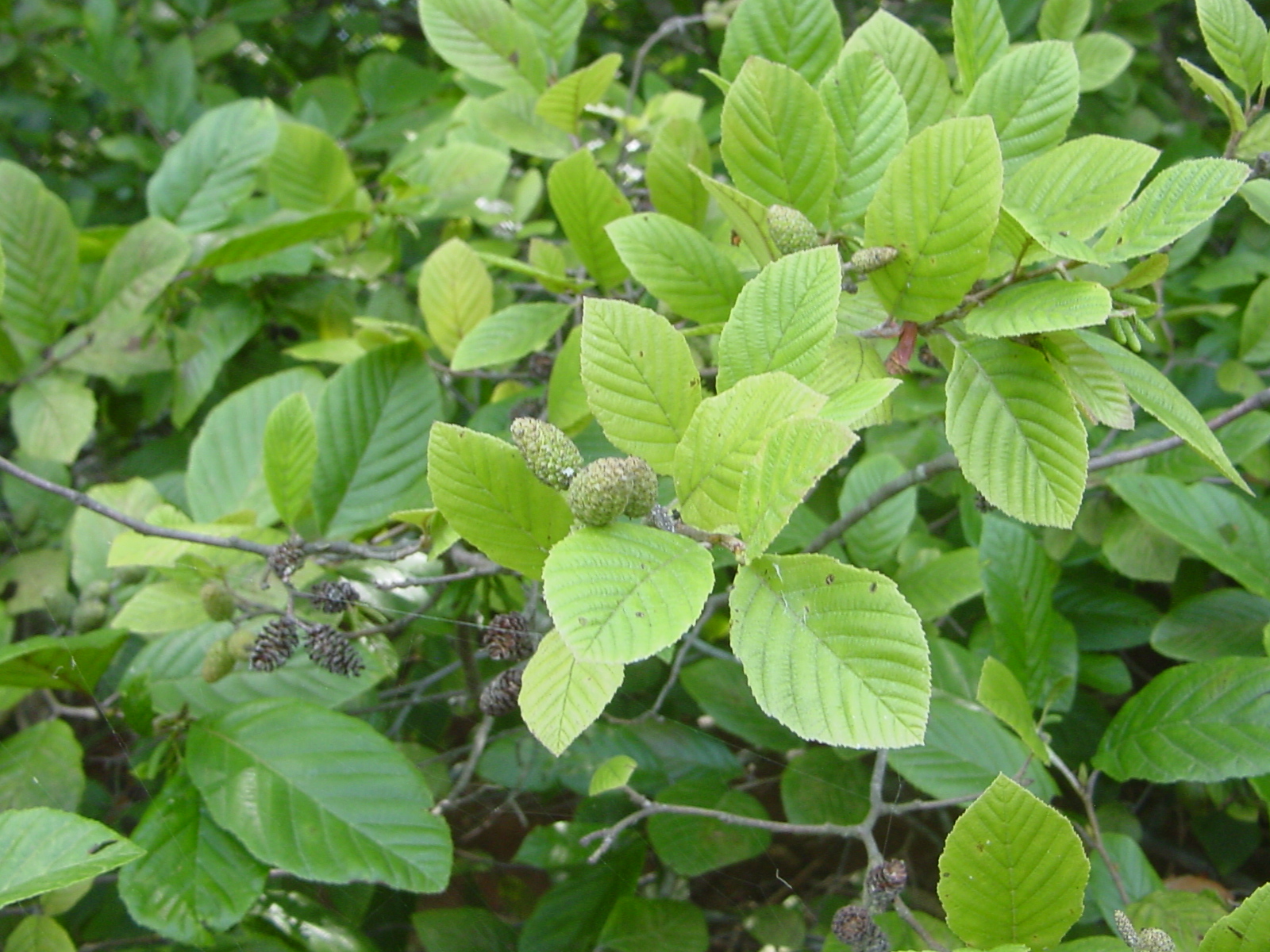
Salix nigra
Black Willow, Swamp Willow
Salix nigra or Black Willow, as it is called, usualy grows about 30 to 60 foot tall sometimes up to and exceeding 100 feet. It needs wet soil and grows in swamps as well as on the banks of streams and lakes being able to withstand flooding and sedimantation arround it's shallow roots. Roots that make it an excellent erosion control plant and is used in many projects including at Smith Mt Lake. The trees produce single or multiple trunks upright and leaning from a common stump. They like full sun and can only tolerate minimal shade. Like all willows it has slinder leaves but on horazontal stems versus drooping like it's weeping cousin. The finely toothed leaves grow to 6 inches long and are green on both sides. Black willows have dark brown to black bark that develops deep grooves and a rough texture with shaggy scales. Tiny yellowish-green flowers on 2 inch long catkins come out concurently with leaves in the spring arround late March to early April with male and female on seperate trees. After polination they produce silky hair seeds easily spread by the wind. The trees attract birds, butterflies, and bees.
Although the wood is soft and weak, it is used for furniture, doors, cabinetwork, boxes, barrels, toys, wooden utensils, and pulpwood. It was one of the willows used to make fine charcoal during the American Revolution to make gunpowder.
The flexible young stems are used in basket and furniture making. When split in half lengthways then sun-dried, it can become the foundation of a coiled basket. The plant is usually coppiced (cut back to the stump) annually when grown for basket making. Also stems can be used for plant support steaks in the garden but be shure to dry them or they will root and sprout.
Collect seed when the capsules begin to dry and turn yellow-brown then break then from the capsule and plant right away. Better yet stems 2-4ft in length and 2-4in wide can be hammered into banks which will root quickly.
Black willows can be found many places along the shores of Leesville Lake solitary or in groves. The shores of the lake portion of the Pigg River has many groves in the alluvian
soil banks out numbered only by the cat tails.
Tolerating severe pruning, black willow makes a great plant for the upper areas of the Leesville Lake flood zone while not obstructing the view. Their shallow roots use the run off nutrients from grassy areas quickly. Also great for swampy conservation zones found mainly in the backs of coves along the lake.
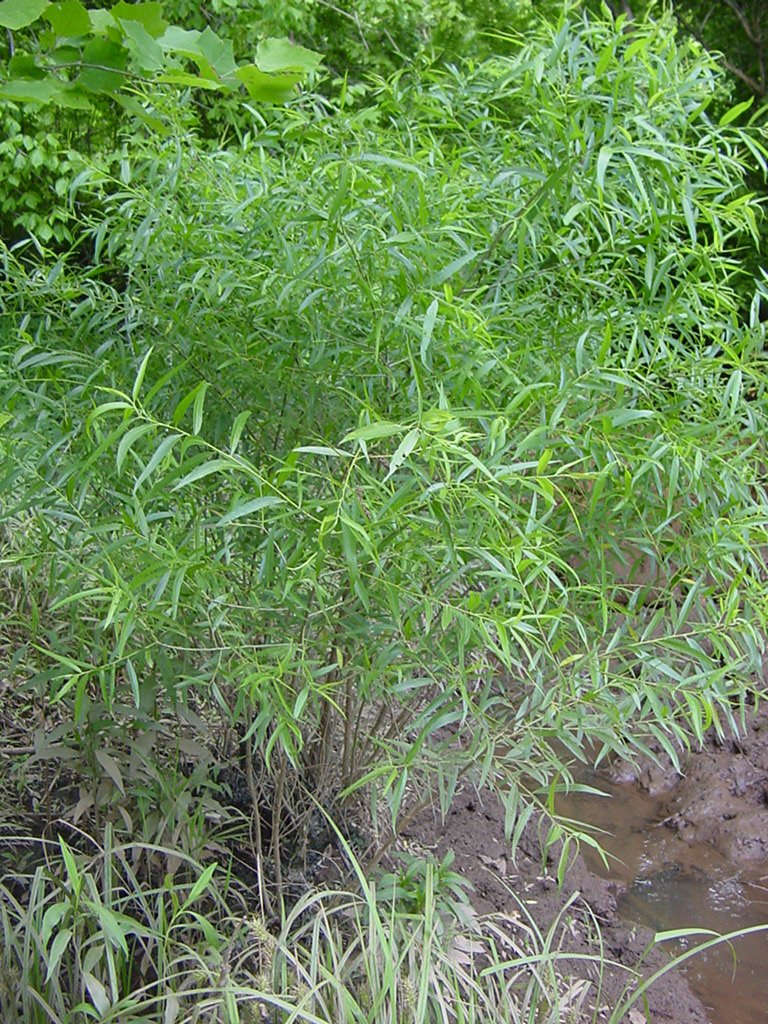
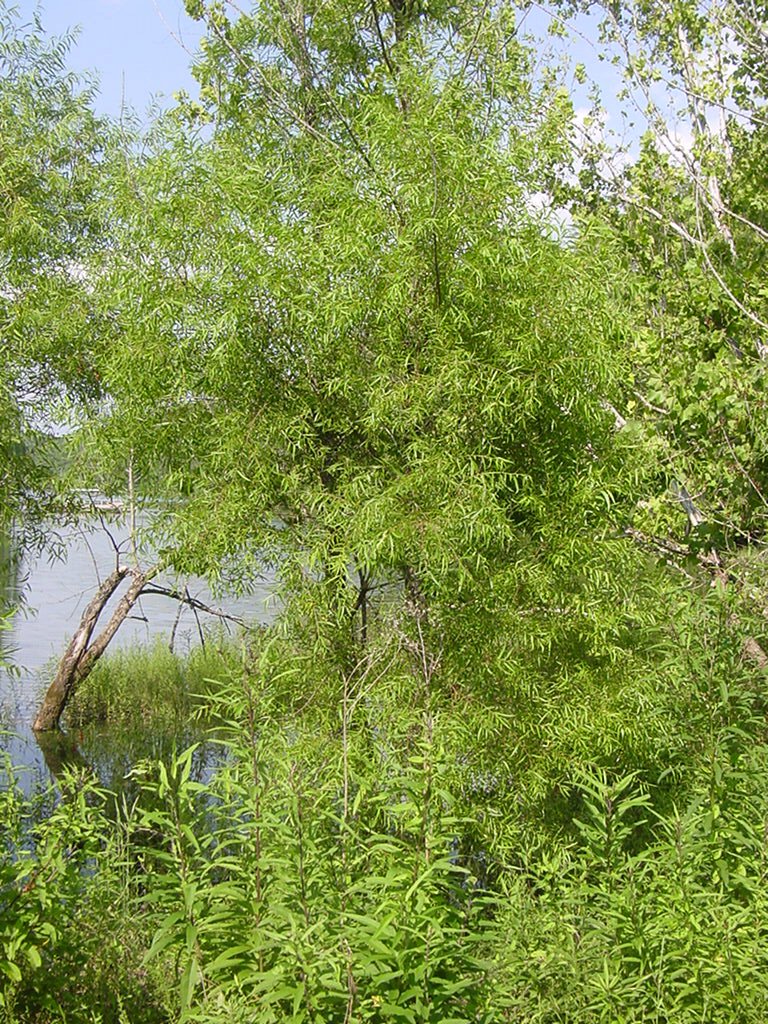
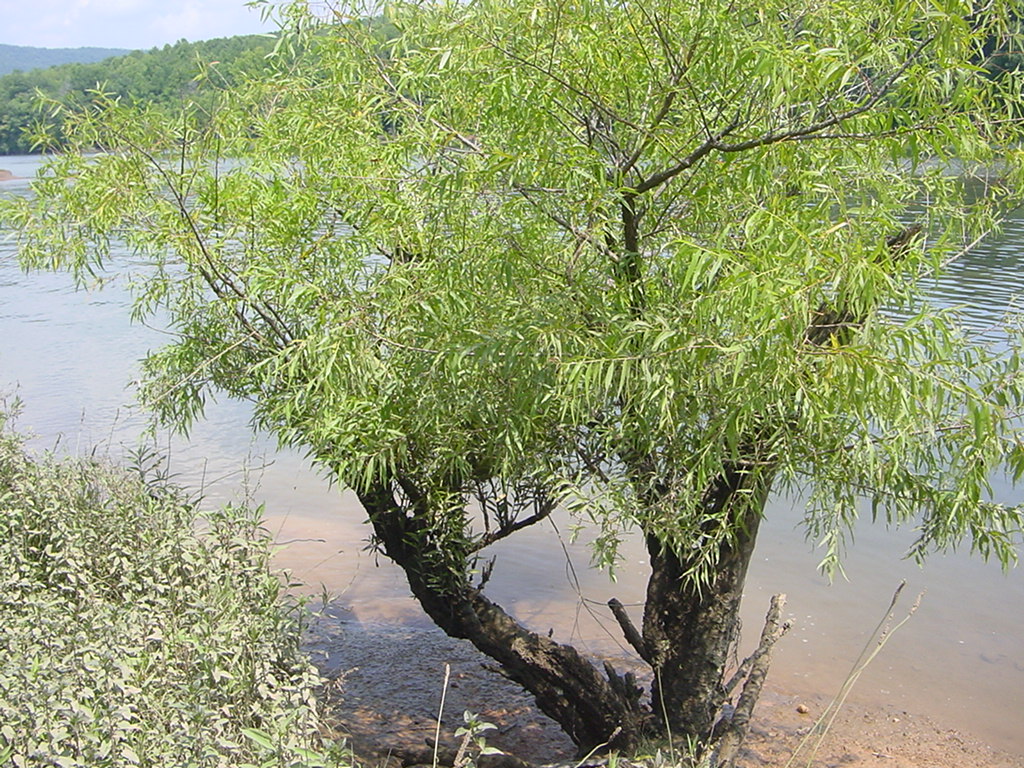
Commelina virginica
Virginia dayflower
Virginia dayflower grows in shallow standing water or where frequent inundation occurs such as along swamps, rivers, streams and ditches in the shade or full sun. The plants need a soil depth of at least 10 inches for good growth making the gental mud slopes of Leesville Lake perfict for them. Fibrous roots grow from nodes of the white rhizomes and the stems may reach 3 feet tall.
From June to August, Virginia dayflower has 1 inch wide light blue flowers with yellow stamens emergeing from spathes that are clustered at the top of stems. One flower per spath per day opens at day beak begining to wilt arround mid-day. There are three petals and the bottom petal is smaller than the top two. The genus name Commelina honors two Dutch brothers who made significant contributions to botany by the top two flowers. A third brother, also a botanist, was far less notable and is represented by the small bottom flower and is white in another variaty of Commelina.
Each fertilized flower forms a capsule inside the spathe it shares with several siblings that bloom in turn. The capsles have three seeds in each that ripen from August to October. Spathes become brown and persist on a green stalk into the fall. Dayflowers die back in winter only to reemerge in spring from the rizomes and roots that help to hold the soil from erosion.
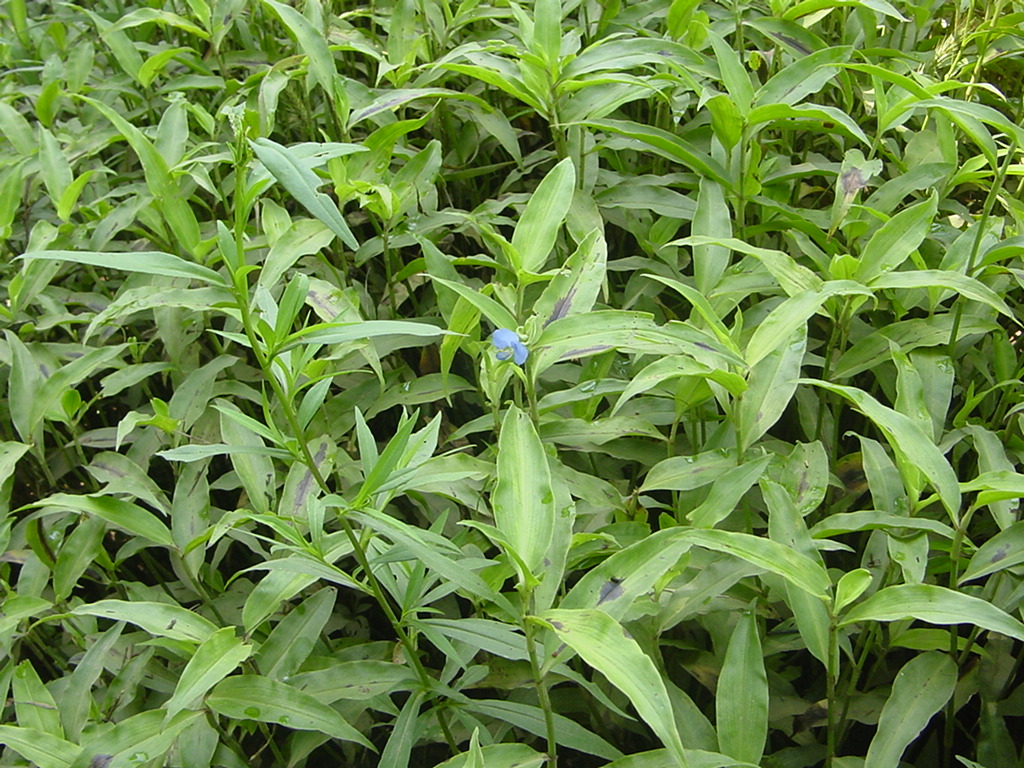
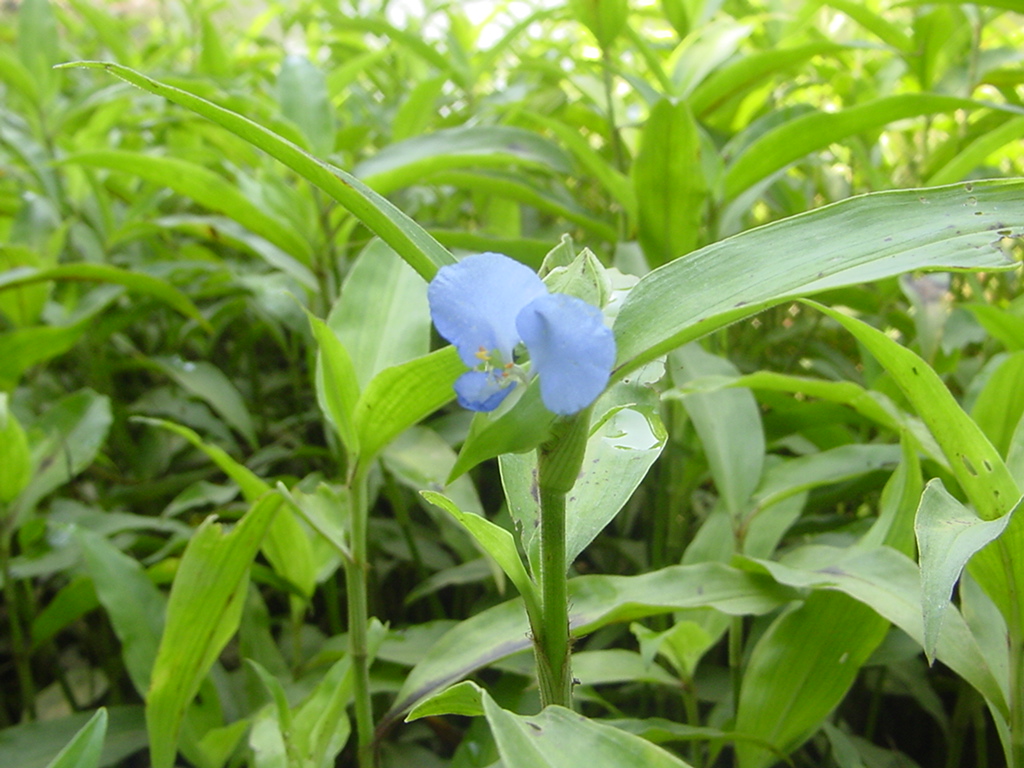
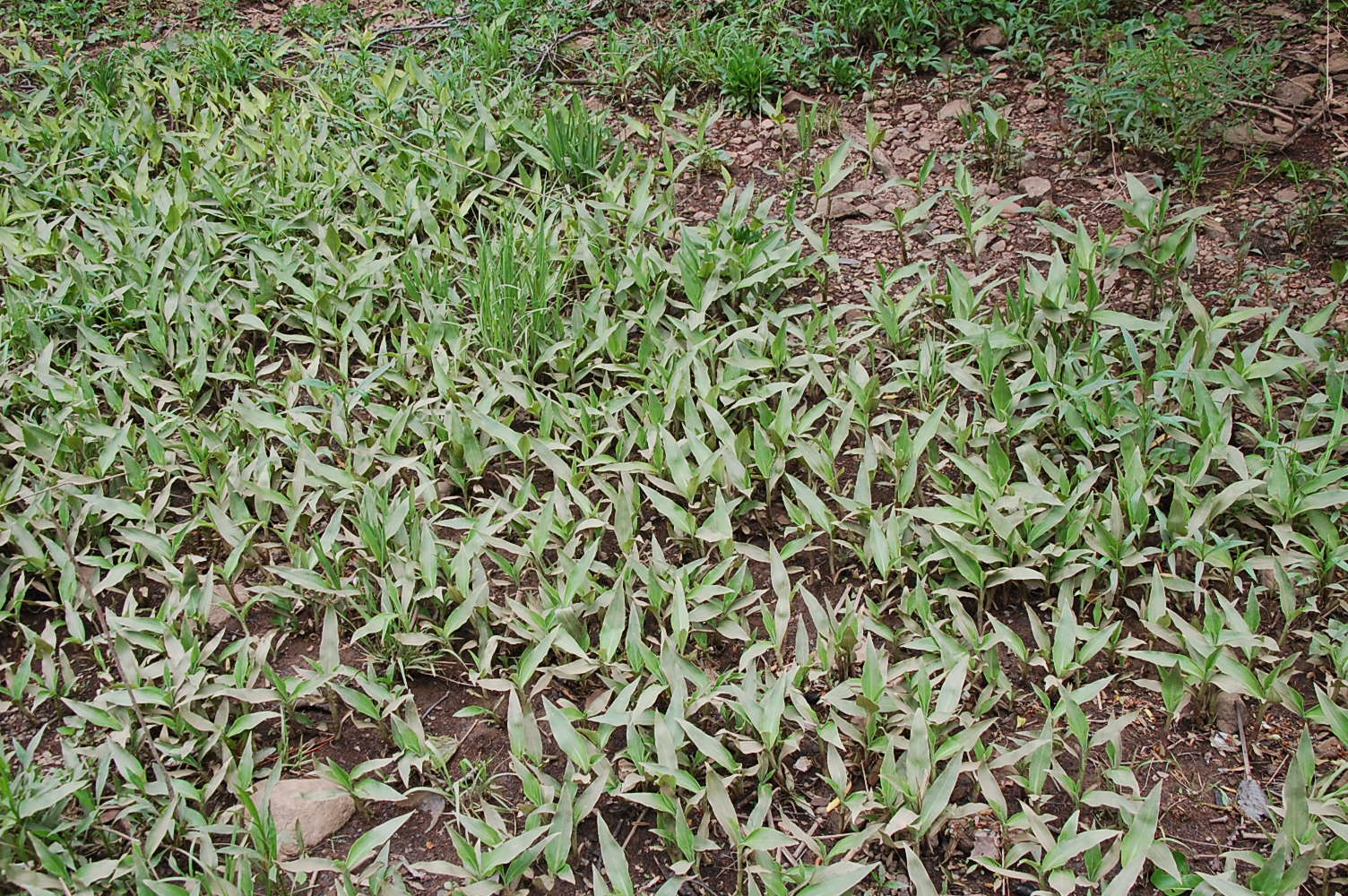
Cornus amomum
silky dogwood, swamp dogwood
Silky Dogwood is a good shrub for wet shady areas. The leaves are similar to the Virginia State flower tree seen in the woods and landscape planting. It's small white blooms emerge in clusters from April to May and bloom into June forming drupes of berries that turn blue in August. Birds are attracted to the fruit and deer do not chew the leaves. It can grow from 6 to 12 feet high and wide in a rounded form sometimes making thickets from stems that touch the ground and root. The leaves and twigs have silky hairs along the undersides. It is often used for erosion controll along the banks of streams and lakes.
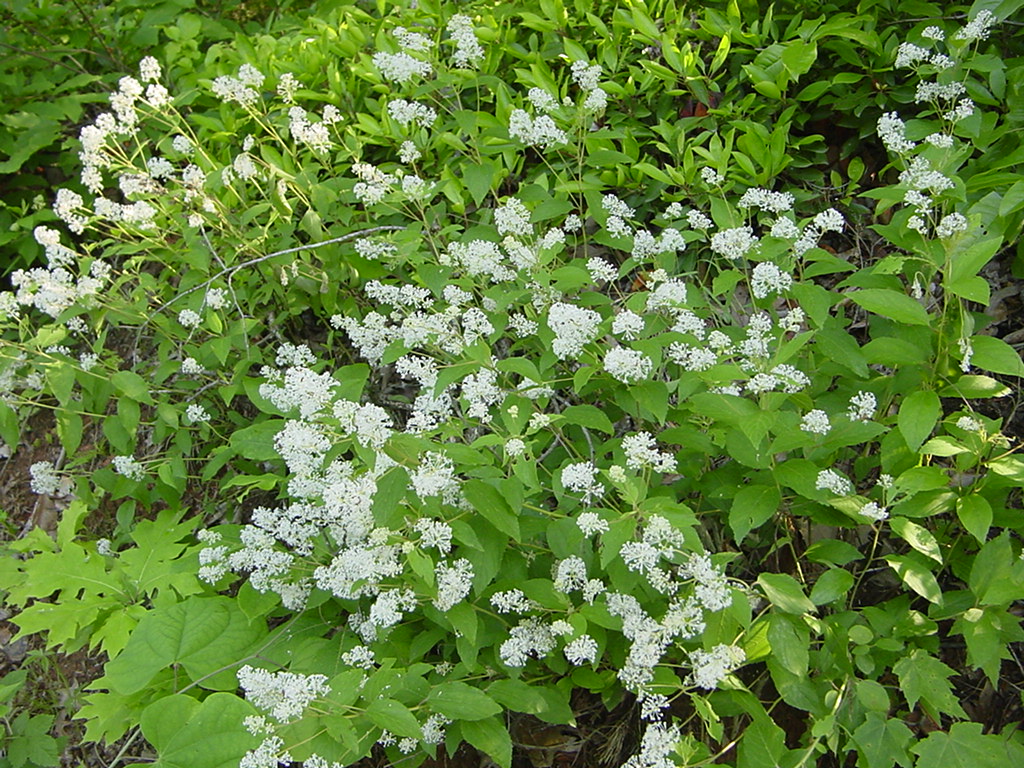
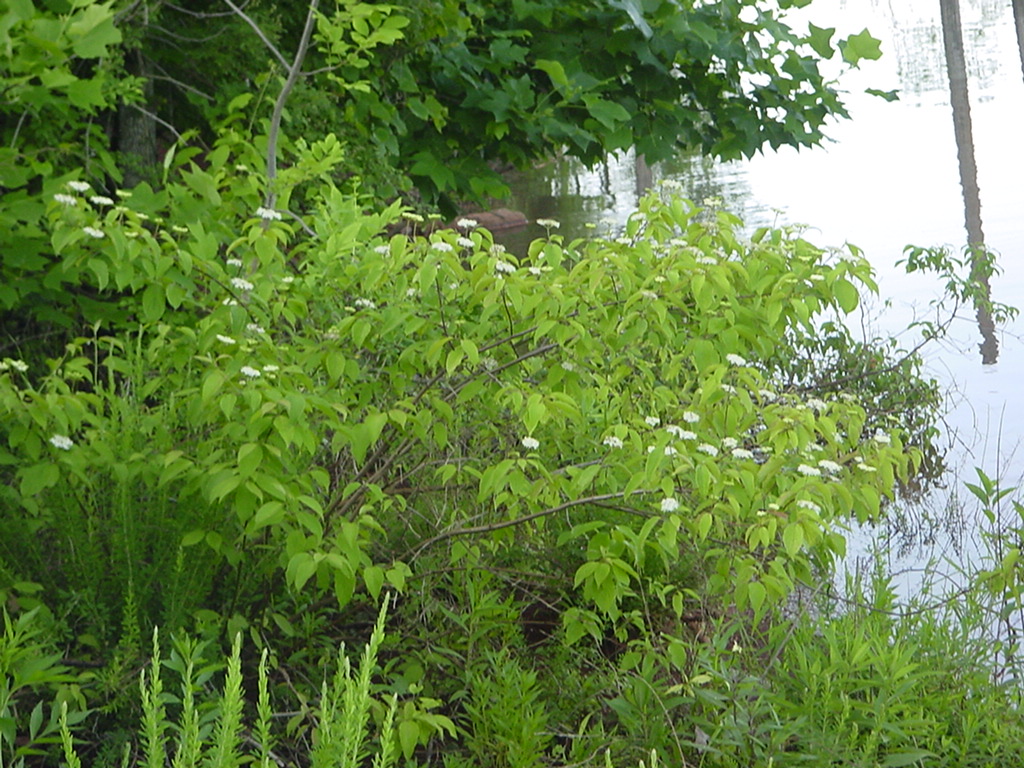
Mentha aquatica
water mint, marsh mint
Water mint is a herbaceous perennial plant that can grow up to three feet in hight. It has green or purple toothed leaves 2.4 inch long and up to 1.6 inches wide that can be hairy to nearly hairless. The flowers are tiny, densely crowded, tubular, and pinkish to lilac in color forming a hemispherical shape. Flowering is from mid to late summer. It grows in shady areas and full sun if in water.
Water mint is pollinated by insects, and also spreads by underground rhizomes forming a ground cover that make it highly effective for erosion control. It was introduced to North America and is native to Europe, Northwest Africa and Southwest Asia. It hybridises easily with other mints shuch as spearmint that produces peppermint.
The leaves can be cooked with foods or eaten raw in salads but be carefull because it has a strong fragrance. Tea can also be made of this sweet tasting mint. You could just rub a leaf and put your fingers to your nose to experience it's flavor.
Mature plants can be divided and transplanted. Cuttings will root easily in soil or water. Also you can collect seed and then sow outdoors in late spring or indoors in late winter.
